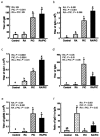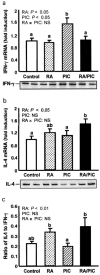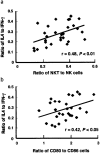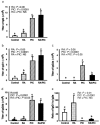Retinoic acid and polyriboinosinic:polyribocytidylic acid stimulate robust anti-tetanus antibody production while differentially regulating type 1/type 2 cytokines and lymphocyte populations
- PMID: 15944302
- PMCID: PMC3843132
- DOI: 10.4049/jimmunol.174.12.7961
Retinoic acid and polyriboinosinic:polyribocytidylic acid stimulate robust anti-tetanus antibody production while differentially regulating type 1/type 2 cytokines and lymphocyte populations
Abstract
Retinoic acid (RA), a bioactive retinoid, and polyriboinosinic:polyribocytidylic acid (PIC) are known to promote immunity in vitamin A-deficient animals. In this study, we hypothesized that RA, PIC, and the combination can provide significant immunoadjuvant activity even in the vitamin A-adequate state. Six-week-old C57BL/6 mice were immunized with tetanus toxoid (TT) and treated with RA and/or PIC at priming in three independent studies of short and long duration. RA and PIC differentially regulated both primary and secondary anti-TT IgG isotypes, whereas the combination of RA + PIC stimulated the highest level of anti-TT IgG production and, concomitantly, a ratio of IgG1 to IgG2a similar to that of the control group. The regulation of Ab response was strongly associated with type 1/type 2 cytokine gene expression. Whereas RA reduced type 1 cytokines (IFN-gamma and IL-12), PIC enhanced both type 1 and type 2 cytokines (IL-4 and IL-12) and cytokine-related transcription factors. Despite the presence of PIC, the IL-4:IFN-gamma ratio was significantly elevated by RA. In addition, RA and/or PIC modulated NK/NKT cell populations and the level of expression of the costimulatory molecules CD80/CD86, evident 3 days after priming. Notably, the NKT:NK and CD80:CD86 ratios were correlated with the IL-4:IFN-gamma ratio, indicative of multiple converging modes of regulation. Overall, RA, PIC, and RA + PIC rapidly and differentially shaped the anti-tetanus Ig response. The robust, durable, and proportionate increase in all anti-TT IgG isotypes induced by RA + PIC suggests that this combination is promising as a means to enhance the Ab response to TT and similar vaccines.
Conflict of interest statement
Figures





Similar articles
-
The anti-tetanus immune response of neonatal mice is augmented by retinoic acid combined with polyriboinosinic:polyribocytidylic acid.Proc Natl Acad Sci U S A. 2005 Sep 20;102(38):13556-61. doi: 10.1073/pnas.0506438102. Epub 2005 Sep 12. Proc Natl Acad Sci U S A. 2005. PMID: 16157890 Free PMC article.
-
All-trans-retinoic acid and polyriboinosinic : polyribocytidylic acid in combination potentiate specific antibody production and cell-mediated immunity.Immunology. 2001 Nov;104(3):341-8. doi: 10.1046/j.1365-2567.2001.01317.x. Immunology. 2001. PMID: 11722649 Free PMC article.
-
Oral vitamin A and retinoic acid supplementation stimulates antibody production and splenic Stra6 expression in tetanus toxoid-immunized mice.J Nutr. 2012 Aug;142(8):1590-5. doi: 10.3945/jn.112.161091. Epub 2012 Jun 27. J Nutr. 2012. PMID: 22739370 Free PMC article.
-
The effects of all-trans retinoic acid on immune cells and its formulation design for vaccines.AAPS J. 2021 Feb 24;23(2):32. doi: 10.1208/s12248-021-00565-1. AAPS J. 2021. PMID: 33629139 Review.
-
The Influence of Antidepressants on the Immune System.Arch Immunol Ther Exp (Warsz). 2019 Jun;67(3):143-151. doi: 10.1007/s00005-019-00543-8. Epub 2019 Apr 29. Arch Immunol Ther Exp (Warsz). 2019. PMID: 31032529 Free PMC article. Review.
Cited by
-
Retinoic acid therapy attenuates the severity of tuberculosis while altering lymphocyte and macrophage numbers and cytokine expression in rats infected with Mycobacterium tuberculosis.J Nutr. 2007 Dec;137(12):2696-700. doi: 10.1093/jn/137.12.2696. J Nutr. 2007. PMID: 18029486 Free PMC article.
-
Leukocyte homing, fate, and function are controlled by retinoic acid.Physiol Rev. 2015 Jan;95(1):125-48. doi: 10.1152/physrev.00032.2013. Physiol Rev. 2015. PMID: 25540140 Free PMC article. Review.
-
The anti-tetanus immune response of neonatal mice is augmented by retinoic acid combined with polyriboinosinic:polyribocytidylic acid.Proc Natl Acad Sci U S A. 2005 Sep 20;102(38):13556-61. doi: 10.1073/pnas.0506438102. Epub 2005 Sep 12. Proc Natl Acad Sci U S A. 2005. PMID: 16157890 Free PMC article.
-
Profile of A. Catharine Ross.Proc Natl Acad Sci U S A. 2005 Oct 4;102(40):14139-41. doi: 10.1073/pnas.0506178102. Epub 2005 Sep 26. Proc Natl Acad Sci U S A. 2005. PMID: 16186491 Free PMC article. No abstract available.
-
An overview on role of nutrition on COVID-19 immunity: Accumulative review from available studies.Clin Nutr Open Sci. 2023 Feb;47:6-43. doi: 10.1016/j.nutos.2022.11.001. Epub 2022 Nov 9. Clin Nutr Open Sci. 2023. PMID: 36540357 Free PMC article. Review.
References
-
- Stephensen CB. Vitamin A, infection, and immune function. Annu Rev Nutr. 2001;21:167–192. - PubMed
-
- West KP., Jr Extent of vitamin A deficiency among preschool children and women of reproductive age. J Nutr. 2002;132:2857S–2866S. - PubMed
-
- Van DE, Kulier R, Gulmezoglu AM, Villar J. Vitamin A supplementation during pregnancy. Cochrane Database Syst Rev. 2002;4:CD001996. - PubMed
-
- Semba RD. Vitamin A and infectious diseases. In: Livrea MA, editor. Vitamin A and Retinoids: An Update of Biological Aspects and Clinical Applications. Birkhauser Verlag Basel; Switzerland: 2000. pp. 97–108.
-
- Ramakrishnan U, Martorell R. The role of vitamin A in reducing child mortality and morbidity and improving growth. Salud Publica Mex. 1998;40:189–198. - PubMed
Publication types
MeSH terms
Substances
Grants and funding
LinkOut - more resources
Full Text Sources

